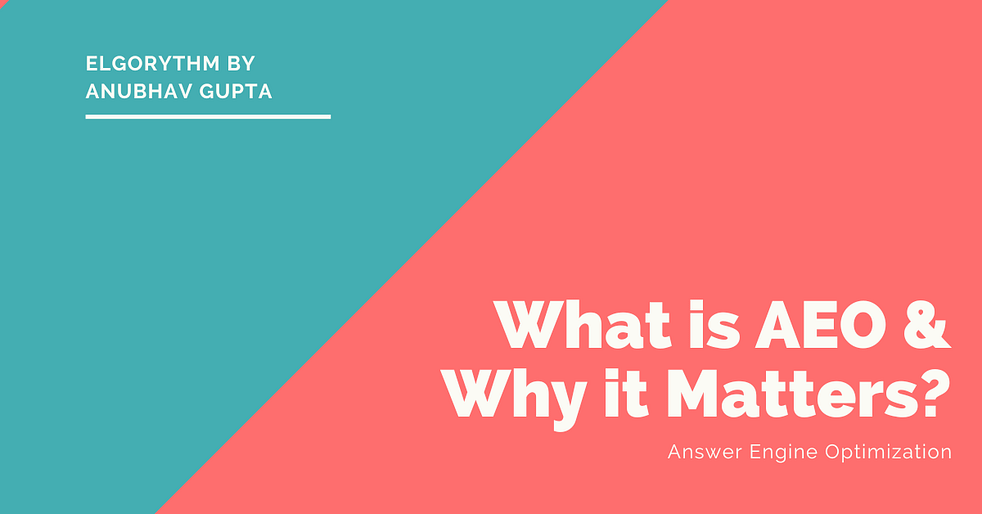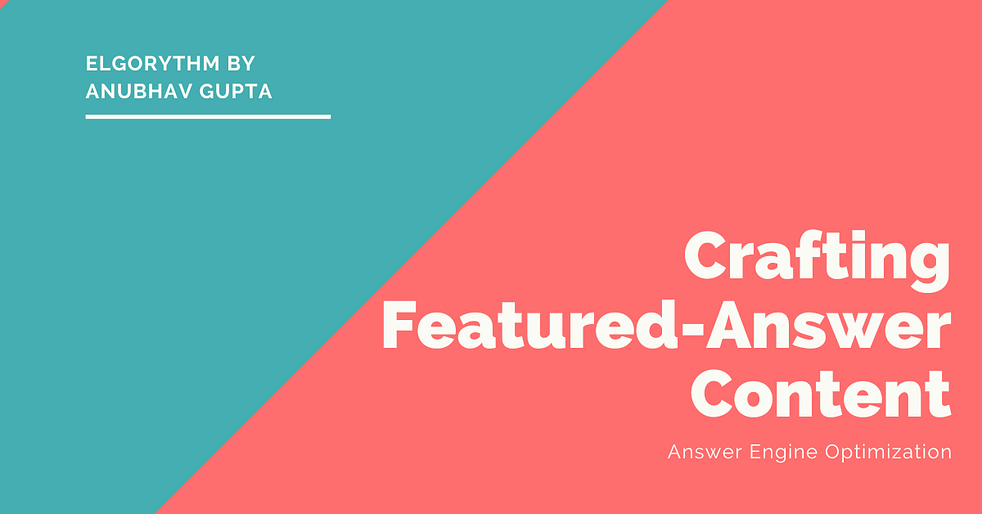1. Introduction: The New Era of Search
The digital marketing landscape is currently undergoing a profound transformation, moving beyond traditional Search Engine Optimization (SEO) to embrace Answer Engine Optimization (AEO). Historically, SEO strategies primarily focused on improving keyword rankings and driving organic traffic to websites.1 However, the contemporary objective of AEO is to provide immediate, direct answers to user queries directly within search results, fundamentally altering how users interact with online information. This evolution is a direct response to significant shifts in user behavior, particularly the growing prevalence of conversational and voice-based searches.1
In this evolving environment, Schema Markup has emerged as an indispensable tool for digital visibility. It functions as a universal language, enabling search engines to comprehend the context and semantic meaning of web content with exceptional accuracy. This deep understanding is paramount for content to achieve prominent placement in direct answer boxes, rich snippets, and voice search results—all critical components of AEO success. Without structured data, the nuances of content can be lost, limiting its potential to serve immediate user needs directly on the search results page.1
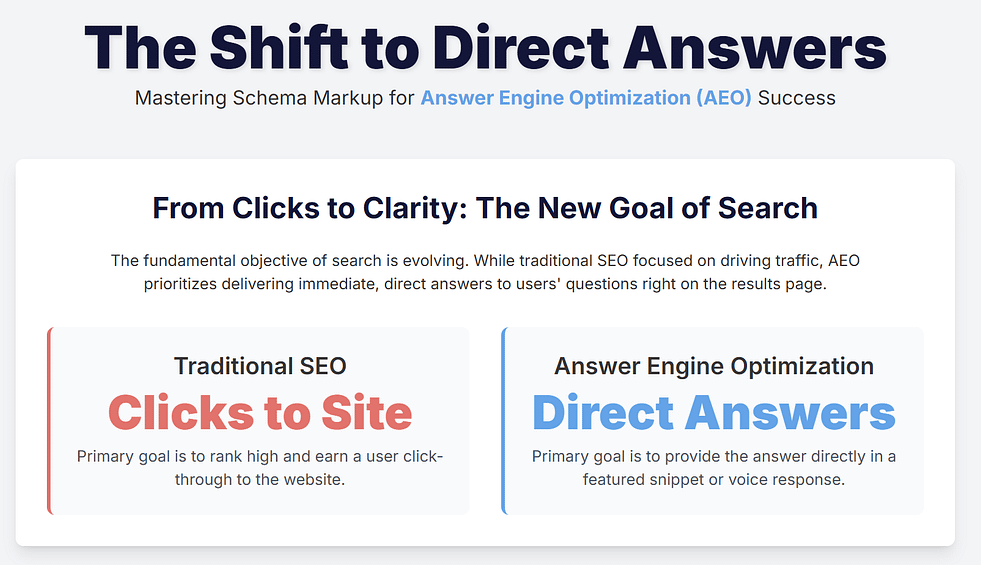
2. Understanding Answer Engine Optimization (AEO): A Paradigm Shift
AEO vs. Traditional SEO: A Fundamental Shift
The distinction between AEO and traditional SEO represents a fundamental shift in digital strategy. Traditional SEO aims to increase organic traffic by improving keyword rankings and encouraging clicks to a website.1 In stark contrast, AEO’s primary objective is to deliver concise, direct answers to user queries directly on the search results page or through voice assistants, often negating the necessity for a click-through. This mandates an optimization approach centered on clarity, conciseness, and direct relevance to user intent, rather than merely focusing on keyword density.1
The Rise of Conversational Search, Voice, and AI Assistants
User behavior has undergone a significant transformation, shifting from brief keyword queries to more conversational, natural language questions. This change is particularly evident with the widespread adoption of smart speakers and AI assistants such as Siri and Alexa.1 Answer engines, powered by sophisticated AI and machine learning algorithms, are specifically engineered to interpret this natural language and deliver immediate, highly relevant responses. This technological advancement and user preference necessitate a content strategy that anticipates and directly addresses these conversational inquiries.1
The consistent emphasis on a shift in user behavior towards conversational, voice-based, and direct-answer queries underscores a critical development in the digital realm. Users now expect immediate gratification and direct solutions within the search results themselves. This change in user expectation has directly spurred the rise of “answer engines,” whose core function is to fulfill these demands by providing quick, direct answers. For businesses to maintain visibility and relevance in this new landscape, adapting their optimization strategies is not merely advantageous but essential. Traditional SEO, with its focus on keyword rankings and driving clicks, becomes insufficient when users no longer wish to navigate away from the search results page for answers. Therefore, the evolution towards AEO is a direct, causal response to both evolving user behavior and the technological advancements, such as AI and voice assistants, that facilitate these new search patterns. This indicates that AEO is not a fleeting trend but a necessary progression for digital survival and continued engagement with target audiences.
3. Schema Markup: The Language of Direct Answers
What is Schema Markup and How it Works with Search Engines
Schema Markup is a semantic vocabulary—a collection of tags or microdata—that can be embedded into a website’s HTML code. Its purpose is to enhance how search engines interpret and present web pages in Search Engine Results Pages (SERPs). By providing search engines with explicit, structured data about content, schema markup allows them to understand the website’s context with greater accuracy. This structured data is instrumental in enabling the display of “rich snippets,” which significantly improve user experience and engagement by offering more informative and visually appealing search results.1
Connecting Schema to NLP and User Intent for AEO
AEO fundamentally relies on a deep understanding of user intent and the capabilities of natural language processing (NLP). Schema Markup serves as a crucial bridge in this relationship. While NLP enables search engines to decipher the meaning and context of unstructured text found on web pages, schema markup goes a step further by explicitly labeling and categorizing information.1 This explicit labeling significantly assists NLP algorithms in extracting precise answers and identifying highly relevant content for direct display. Consequently, schema ensures that content aligns perfectly with what users are truly seeking, facilitating the immediate delivery of information that is central to AEO principles.1
The challenge for search engines lies in precisely extracting specific answers from the vast, often unstructured, content of the web for direct display. Natural Language Processing is a powerful tool used by search engines to understand the meaning and context of human language. However, schema markup complements this by explicitly labeling and categorizing information on a webpage. This explicit labeling provided by schema makes it significantly easier for NLP algorithms to extract precise answers. In essence, schema does not replace NLP; rather, it enhances NLP’s effectiveness, acting as a structured “translator.” It converts the inherent ambiguity of natural language content into a machine-readable format, which is then readily used for direct answer generation. This symbiotic relationship underscores that for AEO, it is insufficient to merely write naturally; content must also be structured in a way that machines can easily parse, making schema a foundational layer beneath the natural language.

Facilitating Featured Snippets, Rich Results, and Answer Boxes
By providing structured data, Schema Markup directly contributes to content appearing as featured snippets, rich results, and within answer boxes. These prominent positions on the SERP offer immediate value to users by answering their queries directly, often without requiring a click-through to the website. This capability is the very essence of AEO, as it prioritizes the immediate delivery of information over traditional click-through rates, aligning with modern user expectations for quick and direct answers.1
4. Essential Schema Types for AEO Success
Different types of schema markup serve specific purposes, each uniquely contributing to AEO success by making particular kinds of information more accessible and understandable to answer engines.
- FAQ Schema: This is crucial for directly answering common user questions within search results. Content marked with FAQ schema often appears as expandable sections in featured snippets, providing immediate answers to user inquiries.1
- Local Business Schema: Essential for businesses with a physical presence, this schema type helps display vital information such as location, contact details, and opening hours directly in local search results and for “near me” queries, driving local visibility.1
- Product Schema: This is vital for e-commerce businesses, providing detailed information about products, including price, availability, and customer reviews, which can appear in rich product snippets and enhance online store visibility.1
- Review Schema: This schema type helps showcase customer ratings and reviews directly in search results, building immediate trust and credibility for the business at a glance.1
Specific Relevance for Indian Businesses
Given India’s rapid adoption of voice-enabled technology and AI assistants, these schema types hold particular significance. Local Business schema is critical for capturing “near me” searches, which are increasingly common. Product schema is vital for the booming e-commerce market, and FAQ and Review schema are crucial for building trust and providing immediate information in a diverse and rapidly digitizing consumer base.1
The global shift towards AEO and the increasing importance of structured data is a worldwide phenomenon. However, the available information specifically highlights India’s accelerated adoption of voice and AI technologies. This rapid integration of advanced search methods in India significantly amplifies the importance of AEO strategies, particularly those that effectively leverage schema markup. Consequently, specific schema types such as Local Business, Product, and FAQ schema become even more potent for Indian businesses. This is because they directly address prevalent search behaviors, such as “near me” searches and e-commerce queries, within that specific market. This demonstrates how a global trend finds a uniquely amplified and tailored application within a specific region, making localized schema implementation a critical competitive advantage.
Essential Schema Types for AEO Success
Schema Type | Description | Key AEO Benefit | Example Use Case |
FAQ Schema | Marks up questions and answers on a page. | Enables direct answers and expandable sections in featured snippets. | A service page with “Common Questions about Our Services.” |
Local Business Schema | Provides details about a physical business location. | Improves visibility in local search and “near me” queries. | A restaurant listing its address, phone, and opening hours. |
Product Schema | Offers detailed information about a product for sale. | Generates rich product snippets with price, availability, and reviews. | An e-commerce product page for a specific smartphone model. |
Review Schema | Displays customer ratings and reviews. | Builds trust and credibility directly in search results. | A product page or service page showcasing star ratings from customers. |
5. Implementing Schema Markup for Optimal AEO Performance
Strategic Keyword Research for Conversational Queries
Effective AEO commences with a thorough understanding of how the target audience formulates questions. Keyword research must evolve beyond traditional single keywords to encompass conversational phrases, long-tail queries, and “near me” searches. Leveraging AI-powered tools can help identify these natural language trends, enabling the creation of content that directly addresses user intent with precision.1
Structuring Content for Direct Answers and Featured Snippets
To maximize the impact of schema, the content itself must be meticulously structured for clarity and direct answers. It is best practice to begin with simple, clear headings, immediately followed by concise, short paragraphs that directly answer the core question. The use of bullet points, numbered lists, and tables is highly recommended to present information in an easily digestible format that search engines can readily extract for featured snippets, enhancing readability and direct answer potential.1
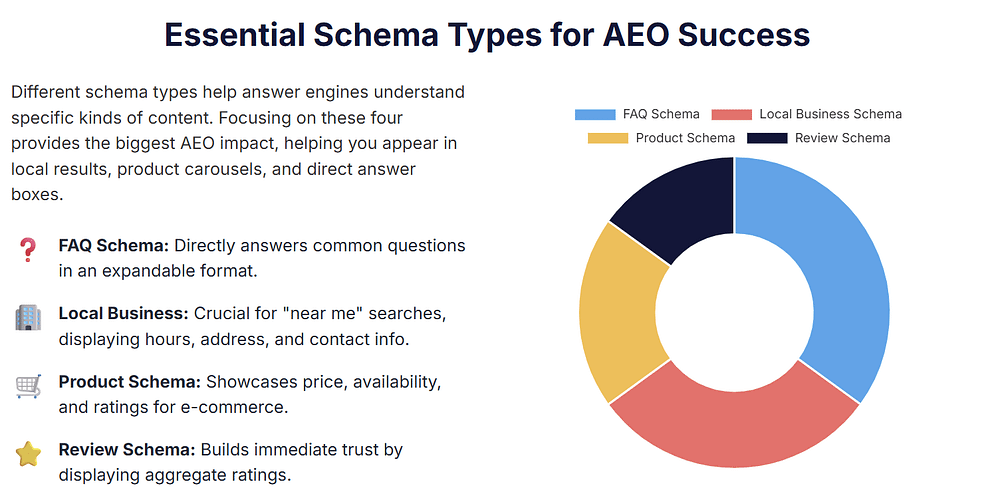
Best Practices for Technical Implementation and Validation
Implementing schema markup requires meticulous attention to detail. Tools such as Google’s Rich Results Test are indispensable for validating the markup and ensuring it is correctly parsed by search engines. Furthermore, it is advisable to regularly monitor search behaviors and update structured data practices to maintain content relevance in the dynamic search landscape.1
Continuous Monitoring and Adaptation
The digital landscape is inherently dynamic, necessitating continuous adaptation. AEO strategies, including schema implementation, should be reviewed and updated regularly, ideally at least every six months. This proactive approach ensures that content remains optimized for evolving answer engine algorithms and adapts to shifts in user search patterns, thereby maintaining its effectiveness and relevance.1
6. Building Trust and Authority with Schema-Enhanced Content
How Schema Contributes to E-E-A-T (Experience, Expertise, Authoritativeness, Trustworthiness)
While the term E-E-A-T (Experience, Expertise, Authoritativeness, Trustworthiness) is not explicitly used in the provided material, the principles are clearly evident. By delivering clear, concise, and accurate answers through schema-enhanced content, businesses inherently establish themselves as reliable sources of information. For instance, Review schema directly showcases customer trust through visible ratings, while accurate Local Business schema builds confidence in a physical presence. This consistent provision of value through direct answers significantly enhances a brand’s authority and trustworthiness in the perception of both users and search engines.1
Leveraging Comprehensive FAQ Pages with Schema
FAQ pages represent a valuable asset for AEO, particularly when enhanced with FAQ schema. They enable businesses to directly address multiple common user queries on a single page, providing concise answers that are ideally suited for featured snippets and answer boxes. This not only improves the user experience by quickly resolving questions but also signals to search engines that the website is a comprehensive and authoritative resource for specific topics.1
Building trust and authority is a critical objective for enhancing online visibility. Traditional methods such as acquiring backlinks, receiving positive mentions from reputable websites, and engaging in social media conversations certainly contribute to a brand’s credibility. However, schema markup introduces a powerful amplification effect. By enabling content to appear as direct answers and rich snippets in search results, schema provides a direct endorsement from search engines. When a business’s content consistently occupies these prominent positions, it is perceived as an authoritative source by users, as search engines are essentially “vouching” for its accuracy and relevance. This means schema does not merely improve visibility; it significantly amplifies existing efforts to build trust and authority by validating the content’s quality directly within the search results, leading to increased brand awareness and credibility. It serves as a direct, visible signal of expertise and trustworthiness, compounding the impact of other credibility-building activities.
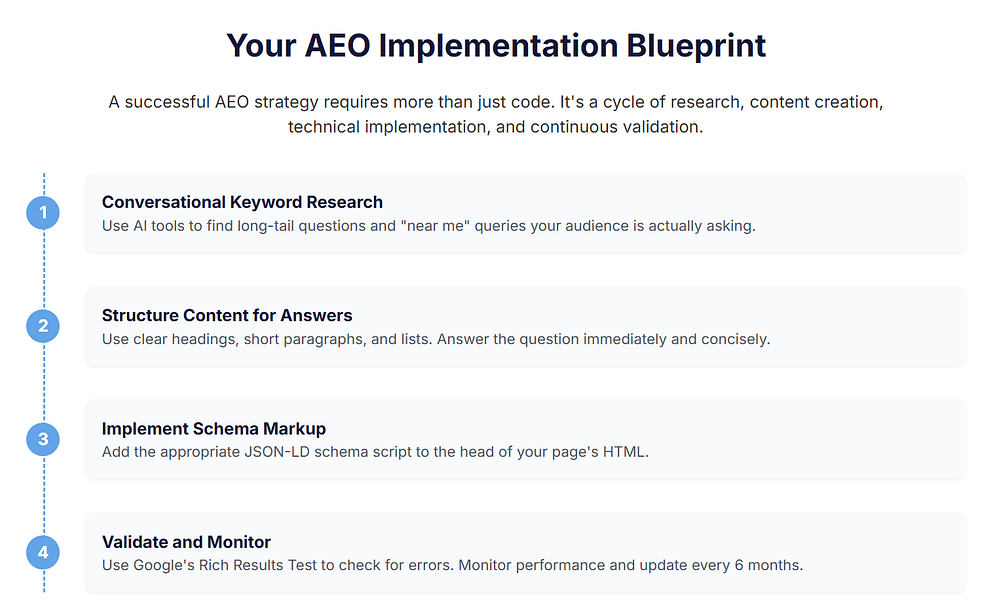
7. Conclusion: Future-Proofing Your Digital Presence
In the rapidly evolving landscape of online search, which is increasingly dominated by answer engines, Schema Markup has transitioned from an optional enhancement to a fundamental requirement for digital success. It empowers content to communicate directly with search engines, facilitating the appearance of direct answers, rich snippets, and voice search visibility. This capability is crucial for businesses aiming to meet the immediate informational needs of modern users.1
By fully embracing AEO strategies and meticulously implementing schema markup, businesses can not only significantly enhance their current online visibility but also effectively future-proof their digital presence against ongoing shifts in search technology and user behavior. This holistic approach ensures that a brand remains discoverable, trustworthy, and valuable to its target audience in an ever-changing digital environment.1
8. Frequently Asked Questions (FAQs)
What is the main difference between AEO and SEO?
AEO focuses on optimizing content to appear as clear, direct answers in answer engines, aiming for immediate information delivery. SEO, conversely, is centered on improving website rankings in traditional search engine results pages to drive organic traffic through keywords and backlinks. Both are crucial for comprehensive digital success.1
How important is voice search for AEO in India?
Voice search holds significant importance for Answer Engine Optimization (AEO) in India. With increasing adoption of voice technology, businesses must prioritize voice search and AEO strategies to remain discoverable and relevant in a market where conversational search is rapidly expanding.1
What role does structured data play in AEO?
Structured data, including schema markup, is fundamental to AEO. It enables search engines to better understand and categorize content, leading to improved visibility in search results. Structured data helps deliver precise answers to user queries, ultimately driving more traffic through specialized search features and rich snippets.1
Can AEO benefit small businesses in India?
Yes, AEO offers substantial benefits for small businesses in India. It enhances their visibility in search results, allowing them to provide clear answers to user queries. This approach helps attract relevant audiences and build customer trust, potentially leading to increased engagement and sales over time.1
How often should AEO strategies be updated?
To maintain effectiveness and adapt to the dynamic search landscape, AEO strategies should be updated regularly, ideally at least every six months. Frequent reviews allow businesses to align with updates in answer engine algorithms and shifts in user behavior, ensuring content remains optimized for current search patterns.1
What is the importance of AEO in Digital Marketing?
Answer Engine Optimization (AEO) is vital in digital marketing because it focuses on optimizing content for featured snippets and answer boxes, providing concise and accurate answers directly on the search page. This reduces the need for users to click through to a website, enhances online visibility, boosts organic traffic, and establishes authority and credibility, ultimately improving user experience and driving conversions.1


